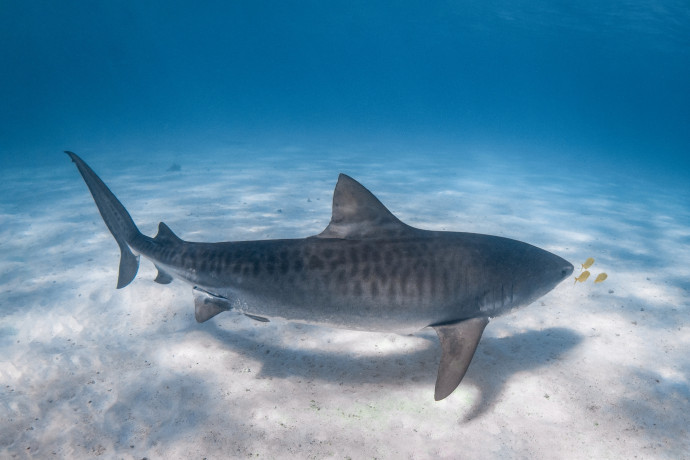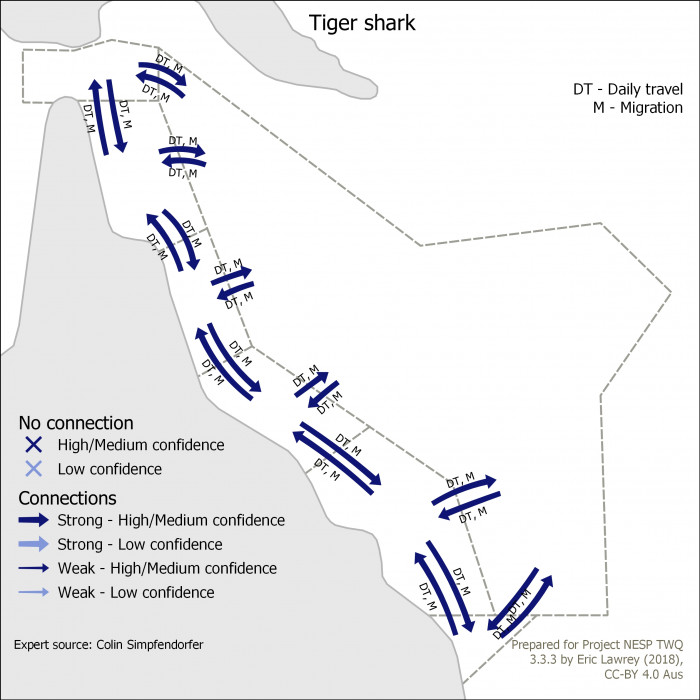Tiger shark
Tiger sharks have a worldwide distribution and although tending to be concentrated in tropical waters are also commonly found in temperate waters (Pepperell, 2010). They are found in all the project jurisdictions and, although they tend to frequent continental shelf waters are also known to take large-scale oceanic migrations (Holmes et al. 2014; Werry et al. 2014). Along the Australian east coast large-scale movements of tiger sharks through Torres Strait, the GBR and Great Sandy Strait are common (Werry et al. 2014).
Using satellite tags Werry et al. (2014) found that mature females displayed the longest migrations and least frequent occurrence on acoustic receiver arrays suggesting they may be the main participants in wide-ranging movements that provide important temporal connections between ‘local’ groups of spatially separated (i.e. 500 km) tiger sharks. For example, the transient nature of mature females in the Chesterfields (west of New Caledonia) compared to sub-adult and mature male sharks supports the notion that large females may move in three year cycles between pupping and foraging grounds on the east coast of Australia and the west coast of New Caledonia with mating taking place in the oceanic reefs in the Coral Sea. Fitzpatrick et al. (2012) also found year round site presence of tiger sharks in some areas of the Great Barrier Reef.
Werry et al. (2014) estimated that tiger sharks utilised three-dimensional activity spaces averaged at 2360 km3. They suggested that mature females may be of primary concern for conservation of tiger shark populations in the Coral Sea and that oceanic Coral Sea reefs may be particularly important for this species.
Tiger sharks are caught in fisheries in the project jurisdictions, but the main source of mortality may be shark control programs on the east coast of Queensland, where hundreds are caught each year to protect popular bathing beaches. Data from the shark control program suggest that although catches have declined, catch rates indicate the population is still relatively healthy.
References
Fitzpatrick, R., Thums, M., Bell, I., Meekan. M.G., Stevens, J.D., Barnett, A. (2012) A Comparison of the Seasonal Movements of Tiger Sharks and Green Turtles Provides Insight into Their Predator-Prey Relationship. PLoS ONE 7(12): e51927. https://doi.org/10.1371/journal.pone.0051927
Pepperell, J.G. (2010) Fishes of the open ocean: a natura; history and illustrated guide. Published by the University of NSW Press Ltd., Sydney, NSW, Australia, 266pp.
Werry, J.M., Planes, S., Berumen, M.L., Lee, K.A., Braun, C.D., Clua, E. (2014) Reef-fidelity and migration of tiger sharks, Galeocerdo cuvier, across the Coral Sea. PLoS One, 9(1), e83249.






